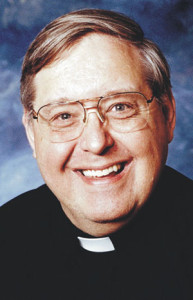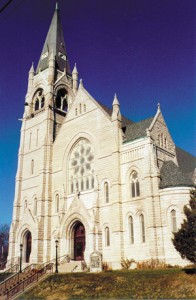By Fr. George McDaniel
For The Catholic Messenger
(Editor’s note: In an effort to create greater awareness of and appreciation for the seat of the Davenport Diocese — Sacred Heart Cathedral — The Catholic Messenger is publishing a brief series of articles about the home of our diocese. Bishop Martin Amos has designated the second weekend of February as Cathedral Sunday.)

The story of Sacred Heart Cathedral begins with Antoine LeClaire and his wife, Marguerite. With a French father and native American mother, Antoine LeClaire spoke French, Spanish, English and 14 Indian languages and dialects. This skill enabled him to enter government service as a translator. He was involved in the negotiation of a number of treaties between the United States government and native American tribes. Through his friendship with those tribes he received sections of land in what is now Davenport and LeClaire; in 1833 the LeClaires settled on that land. He quickly became an important citizen: justice of the peace, founder of a ferry service to Rock Island (Ill.), and was among those who platted the town of Davenport. But his longest-lasting contribution was to the Catholic Church.

The LeClaires’ home became the early center of Catholic life in Davenport. In 1836 the Dominican missionary Father Samuel Mazzuchelli celebrated the first known Mass in the area in their home. When Fr. Mazzuchelli wanted to establish a church, LeClaire donated the land known as the “church square” in downtown Davenport and the two of them laid out the plans for St. Anthony’s church.
As Davenport grew, another parish church was needed for the Irish immigrants who had settled in the east side of Davenport in an area that became known as Cork Hill. To serve them, LeClaire donated land on a high bluff overlooking the river for a new church.
The new church was named St. Margaret’s in honor of LeClaire’s wife, Marguerite. Antoine LeClaire directed the construction of the church. When St. Margaret’s was dedicated in 1856, a commentator wrote that its “spire reaches from the lofty bluff till it would almost seem to touch the quiet stars or to mingle with the cloudy glories of a summer’s day.”
Next, LeClaire built a small-frame rectory next to the church which within a few years was replaced by a brick rectory, also paid for by LeClaire.
That same year Bishop Mathias Loras named Father Andrew Trevis as the first pastor of St. Margaret’s. However, his health began to decline and in 1861 he resigned the pastorate and returned to his native France. His assistant pastor, Father Henry Cosgrove, became the new pastor, a position he would hold until he became the second bishop of Davenport in 1884.
LeClaire had only a few years in which to enjoy “his” church; he died in 1861 and was buried on the church grounds. His contributions to Catholicism had been great: St. Anthony’s and the “church square,” St. Margaret’s church and two rectories, 20 acres on the north edge of town for what became St. Marguerite’s — later Mount Calvary Cemetery — and just before he died he had purchased an organ for St. Margaret’s.
As the parish grew, Fr. Cosgrove turned his attention to the religious education of the children. In 1860 the Sisters of Charity of the Blessed Virgin Mary came from Dubuque to teach. For the first 10 years they used rooms in the convent and in the west wing of the church as classrooms. Then in 1870 the parish constructed a two-story school building on 11th Street behind the church. This served as the parish school until 1915 when a new school building was erected across 11th Street.
As the number of Catholics in Iowa increased, the responsibilities of the Bishop of Dubuque increased.
The Diocese of Dubuque included the entire state of Iowa and as early as 1862 the Bishop of Dubuque had petitioned Rome to divide the diocese. Davenport became the leading contender as the new see city (jurisdiction of a bishop), in part because of the financial stability created by income from the “church square” which Antoine LeClaire had donated years before. Finally, in May 1881, Pope Leo XIII created the new Diocese of Davenport and named the Rev. John McMullen, 49, of Chicago as the first bishop.
Fr. McMullen was ordained a bishop on July 25, 1881, and came to Davenport on July 30. Even before he arrived, he had made the decision that St. Margaret’s would be the cathedral. He took up residence at the cathedral rectory. He continued to live there until the priests of the diocese purchased the former LeClaire home a few blocks east of the cathedral as the bishop’s residence.
Bishop McMullen’s time as the bishop would be short; his heath began to decline and he died on July 4, 1883, at age 51. He was succeeded as bishop by Fr. Cosgrove. In one of his first appointments, Bishop Cosgrove appointed Fr. Trevis, who had returned from France, to once again be the pastor of St. Margaret’s.
Even before Davenport became a diocese there had been discussions about the size of St. Margaret’s and whether it was large enough to serve the growing parish community. Now it was clear to Bishop Cosgrove and others that it was too small for the larger role it would play as the cathedral church. The question was whether to remodel and enlarge or tear it down and build a larger church. The clergy and local businessmen Bishop Cosgrove consulted agreed that the cost of remodeling and enlarging would be too great; so the decision was made to build a new church.
On Sunday, March 3, 1889, Bishop Cosgrove announced that a new church would be built at a cost of between $80,000 and $100,000. He said there was $3,000 from the St. Margaret’s fair held the previous year and another $7,000 in pledges. By June the plans for the new church were complete and ground was broken that month. The local firm of Walsh and Edwards was chosen as contractor. The Catholic Messenger commented that a new cathedral would “be a credit to the diocese—an ornament to the see city.”
At the end of 1889 the bishop announced that $10,000 had been spent so far. Interest in the project was high and when the bishop laid the cornerstone on April 27, 1890, the other parishes in the city changed their Mass times so people could attend the celebration. The next September The Catholic Messenger reported that “nothing of importance [was] unfinished . . . but the bell tower.”
While the diocese prepared for the new cathedral, Bishop Cosgrove was quietly at work to bring about another change. Early in 1889 he had petitioned the Holy See for permission to dedicate the new cathedral to the Sacred Heart. Fr. Trevis had a longtime devotion to the Sacred Heart. During his years in France he often visited Paray-le-Monial where St. Margaret Mary Alacoque had experienced the visions that popularized the devotion. Bishop Cosgrove was also devoted to the Sacred Heart and made an image of the Sacred Heart central to the design of his episcopal coat of arms. On Dec. 23, 1889, Pope Leo XIII granted permission to change the name of the cathedral to Sacred Heart provided that a chapel was maintained in honor of St. Margaret.
Meanwhile, the bishop continued to raise the remaining money to finish the project. In July 1889 the first envelope subscription was taken up in the parish. In September, a Cathedral Fair was held with games and prizes which raised $2,418.20. A good deal of the fund-raising in the parish fell to the pastor. But in1889 Fr. Trevis’ health began to decline again and he resigned. Bishop Cosgrove appointed Father James Davis, 37, as the new pastor.
Bishop Cosgrove saw construction of the cathedral church as a diocesan project and on Jan. 1, 1891, he wrote the priests of the diocese with a report. He said that to date the cost of the project was $52,264.90 and that he expected another $30,000 would be needed to finish the building. He said the parishioners of St. Margaret’s and the people of the city of Davenport had been generous and now he was turning to the entire diocese for help. He wrote, “As the Cathedral church is in a manner the parish church of the whole diocese, and belongs to no particular congregation, but to all the congregations in the diocese, it is and always has been the custom to call upon all the priests and congregations to contribute.” He told the priests that the parishes would be expected to provide one-third of the cost and in January 1891 the bishop released the assessed amount for each parish. The Messenger wrote of the hope that “the Catholics of the diocese who are blessed with an abundance of this world’s goods and grateful hearts, will respond freely” to the bishop’s call for funds.
Finally it was completed. The dedication of the new cathedral was set for Sunday, Nov. 15, 1891. It rained hard that Sunday, but still the people came. In addition to the bishop of Davenport, the bishops of Peoria, Dubuque, Omaha and Wichita were present as were priests from throughout Iowa and western Illinois. Civic Davenport was represented by the mayor and city council, the county supervisors and the Business Men’s Association. But the largest group was Catholics for whom the cathedral was the parish church of the diocese. The next day the Davenport Democrat noted that the dedication was “an event which is rightly celebrated in Davenport, but [also] throughout the southern half of Iowa which constitutes the diocese of the Roman Catholic Church.”
In the years that followed, more change took place on Cork Hill. The old church was torn down and the bricks were used to build a series of houses on Seventh Street. The brick rectory was torn down and replaced with the stone rectory which still stands. In 1893 the remains of Antoine and his wife, Marguerite who had died in 1876, were removed from the parish grounds to the new cemetery Antoine had made possible. In 1895 Fr. Davis bought a new organ to replace the one Antoine LeClaire had ordered just before his death in 1861.
A building is a living thing; it changes over time to meet the needs of the people who use it. If the original St. Margaret’s was a sign of the faith and generosity of Antoine LeClaire, Sacred Heart Cathedral stands as a sign of the faith and generosity of the people of the Diocese of Davenport who built it and who continue to come to worship together as the local church of Davenport.








